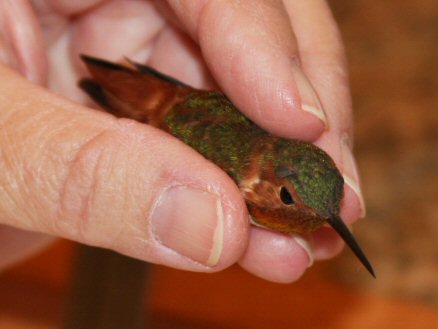

The Winter Hummingbird Project | |
|
The first fall after Nancy began attracting hummingbirds to her yard, she noticed first a Selasphorus (probably Rufous) Hummingbird among the Ruby-throats, and then as the Ruby-throats began to thin out, she noticed a couple of other birds that just didn’t quite look the same as the others. Finally, one day, one of them turned just right in the sunlight and she saw that a couple of the feathers in its gorget were purple. It was an immature male Black-chinned, and by mid December she had no less than seven of them in her yard – each identified by a different pattern of gorget development. At the time, there were only eight previous records for Black-chinned Hummingbird in the state, so her report that she had seven at one time was greeted with, shall one say, considerable skepticism. (One person declared she had to be lying as no one could have that many hummingbirds in winter, much less a species as rare as Black-chinned.) She invited Robert Newman of the LSU Museum of Natural Science and one of the state’s premier ornithologists to check them out, and he left her yard a believer. The following year, she had a Buff-bellied Hummingbird, only the fourth or fifth record of that species. A year later she had an Allen’s, both years also having additional Selasphorus, some definitely Rufous. As she put it, “I knew that there was something going on here, but nobody was all that interested in it. Everyone believed that winter hummingbirds here were lost and would die when it turned colder, but that didn’t explain why they kept turning up in the same yards, year after year.” She suspected that some of these birds were, in fact, surviving the weather and returning to the same wintering site, and told Newman that this would make a good master’s thesis project for an ornithology student. At the time, LSU’s program was really making enormous strides in tropical ornithology, and Newman gently informed her that graduate students typically came to LSU in order to go to South America and discover species new to science. “So why don’t you do it?” he asked her. And she did, despite not having finished college herself, and despite being a thousand miles away from the nearest hummingbird banding permit holder; developing her own technique for handling the birds, and with access to the LSU Museum’s collection for study purposes, Nancy set out with her banding permit in July 1979 to conduct a five-year study of wintering hummingbirds in Louisiana. That study, which began its thirty-fifth year in the summer of 2013, has documented thousands of wintering hummingbirds in the state. After years of slow but steady growth, numbers of reported and banded hummingbirds shot up dramatically just after the turn of the century, but have since fallen back somewhat; and all the while, each year has brought surprises and interesting new information. Details from the last several years can be found in the links to the right. |
 Allen's Hummingbird, Adult Male, being banded. Photo by Kevin Morgan Winter Hummingbird Project Report, 2013-2014
Winter Hummingbird Project Report, 2012-2013
Winter Hummingbird Project Report, 2011-2012
|